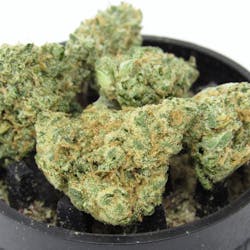This article was updated March 22, 2021
You’ve heard it before when it comes to cannabis strains: Sativas will pick you up for energetic daytime activities, while indicas will put you in the couch when you want to relax and wind down at the end of the day.
But the indica/sativa classification is incomplete. There’s a better way of predicting the effects of a cannabis strain before you buy and consume it: by looking at its cannabinoid and terpene profile. Leafly has designed a new visual system to help you easily understand.
Rooted in science and incorporating test data from lab partners across the US and Canada, Leafly’s new Cannabis Guide will help you select a cannabis strain for any activity, mood, or time of day, suited to your particular body and needs.
In this first part, we’ll show you how to use the new system, whether you’re a novice or connoisseur and regardless of what you are looking for: happy or euphoric feelings, a calm or energizing state of mind, or particular wellness benefits.
To learn why Leafly has created a new visualization system for cannabis, check out Part 2 of this series.
Get started
Don’t let change overwhelm you: Leafly’s new system uses simple shapes and colors to help you find the best strain for you. Let’s dive in.

The above strain card shows all of the elements of a Leafly flower in the new Cannabis Guide. When looking for a strain, we recommend you go in this order:
Find your shape (cannabinoid), find your color (terpene), find your cannabis (strain).
What do shapes mean?

Shapes are one of the most integral pieces of the system. They represent cannabinoids (ca-NA-bi-noids), which are compounds like THC and CBD that drive the effects of cannabis. More on this later.
Most cannabis strains are mainly composed of either THC or CBD, or a mix of the two. The center shape—or nucleus—represents THC or CBD dominance:
- Diamonds are THC-dominant strains
- Circles are CBD-dominant strains
- Strains with a balanced amount of THC and CBD have a mix of circles and diamonds in the rings; Harlequin is a good example
The larger the shape, the higher the percentage of THC or CBD—longer, pointier diamonds mean more THC, and bigger circles mean more CBD.
A few minor cannabinoids, such as CBG, are also included in the system. Today, however, most cannabis strains contain THC and CBD.
Shop highly rated dispensaries near you
Showing you dispensaries nearHow do I find a euphoric strain with THC?

THC is the main psychoactive compound in cannabis—it gets you high, and it’s known to help with pain relief, nausea, and appetite loss.
If you want a strain with high THC levels (for more of a high), look for longer and pointier diamonds. If you want something with just a little bit of THC (and less of a high), look for smaller, shorter diamonds.
How do I find a strain without the high?

CBD is the non-intoxicating compound in cannabis that provides many wellness benefits, so you’ll look for circles. CBD can even help decrease some of THC’s side effects like anxiety or temporary short-term memory problems.
Something with a lot of CBD will have big circles. Small circles means it has just a little bit of CBD.
Today’s market consists mainly of THC-dominant strains, so CBD strains will be less common. Some popular CBD strains are ACDC, Cannatonic, and Sour Tsunami.
What do colors mean?

Colors represent terpenes, which make up the flavors and smells of cannabis, including sweet, citrus, skunky, or diesel scents. Terpenes are oils secreted by trichomes, the sticky glands on cannabis plants. Other plants and fruits also produce terpenes.
Terpenes help give each strain its distinct personality and may also influence the effects of cannabis through something known as the “entourage effect” (more on that in Part 2). More research is needed to fully understand how terpenes affect the body.
More than 100 terpenes have been identified in cannabis, but some are more common than others. Leafly’s Cannabis Guide highlights eight of the most common.
Each Leafly flower shows the three most abundant terpenes: The large, medium, and small rings around the center shape indicate primary, secondary, and tertiary terpenes, respectively.
Different terpenes may lead to different experiences. Experiment with different colors (terpenes) to find which combinations produce the right feelings and effects for you. If you find a strain with a dominant terpene that you like, you will likely enjoy a different strain with that same dominant terpene.
Why do some flowers appear without color?
When searching for flowers in the new system, you’ll notice that some don’t include colors. These strains do not have enough terpene data yet to establish a reliable terpene profile (colors), but they do have enough data for a cannabinoid profile (shapes).
In the US, cannabinoid and potency testing is required by state law in legal markets, so all cannabis sold through state-legal stores will have cannabinoid data. But testing for terpenes is not required by law and costs extra money, so a lot of growers don’t elect to have it done.
Similarly, in Canada, licensed producers (LPs) must provide cannabinoid potency for all cannabis products. Although some LPs may elect to test for terpenes as well, this information can only be communicated on supplementary materials, not directly on packages.
Leafly is working to create a terpene profile for every strain. We intend for our new Cannabis Guide to encourage both growers and consumers to take more of an interest in terpene data and how it can help ensure a reliable, enjoyable experience.
The importance of exploring different strains
It’s still hard to predict the effects a strain may have on a specific individual because every individual, every experience, and every set and setting are different. Even if the same individual smokes the same exact strain at two different times, it can affect them differently.
An analogy for using the Cannabis Guide to find a strain for yourself is online dating: You can get a sense of someone’s personality from a dating profile, but you’ll have to go on a date to see if you really match.
Similarly, in telling you the cannabinoid and terpene profile of a cannabis strain, the Cannabis Guide will give you an accurate depiction of a strain’s chemical profile, but you still need to try different strains to find the right type of strain for you.
Once you find a shape and color combination that gives you desired feelings and effects, you can keep going back to that kind of strain. Also, if a strain has negative effects for you, a strain with a similar profile will likely lead to negative effects as well.
How to use the Cannabis Guide to find the perfect strain for you
You’ll see a few options when you go to both Leafly’s app and homepage:
- The Cannabis Guide homepage, which includes a brief explainer on how to use the new system
- Suggested strain lists—curated groups of strains based on feelings, activities, or experiences
- The Flower Finder, which allows you to create a flower by picking your preferred cannabinoid levels and terpenes; the system will then pull up strains based on the parameters you put in
To create a flower, remember: Find your shape, find your color, find your cannabis.
First, pick your shape, or THC and CBD levels. You can have all THC, all CBD, or a mix of both.
Next, pick a color, or terpene. These are the eight terpenes in the Cannabis Guide—ordered from calming to energizing—and information about each based on research and thousands of customer reviews:
- Linalool (purple): Floral, also found in lavender; it’s reported to promote pain relief and relaxation.
- Myrcene (dark blue): Earthy; it’s the most abundant terpene found in cannabis; commonly believed to have sedative and muscle-relaxing effects.
- Pinene (green): Pine flavors; also found in rosemary and many other herbs; it has been studied for its anti-inflammatory effects and may combat short-term memory impairment from THC.
- Humulene (light green): Woody flavors; reported to have antibacterial and anti-inflammatory properties.
- Caryophyllene (fuchsia): Spicy and peppery; rodent studies have shown that it can act as an anti-inflammatory, relieve pain, and may even treat anxiety and depression.
- Limonene (yellow): Citrus flavor; rodent studies reported have shown that it can provide relief from anxiety and stress.
- Ocimene (bright red): Sweet flavors; commonly used in perfumes; reported to have anti-inflammatory properties.
- Terpinolene (orange): Fruity flavors; reported to have antibacterial and antifungal qualities.
With your cannabinoids and terpenes locked in, the Flower Finder will then give you a list of strains you might like based on your inputs.
We encourage you to test out and explore the system!
Want some terpene-based recommendations? Check out our lists of strains rich in popular terpenes:
- Limonene-dominant strains
- Terpinolene-dominant strains
- Caryophyllene-dominant strains
- Myrcene-dominant strains
- Strains with pinene
How do I find a related—or unrelated—strain?
After you try a strain, note how it makes you feel. You can do this by signing up for an account and leaving a review on Leafly, or by keeping a personal diary at home. Then use the Cannabis Guide to find the strain’s chemical makeup. Because a strain’s effects are related to its chemical profile, a strain with a similar chemical makeup is likely to provide similar feelings.
To find a similar strain or feeling, first look for a similar cannabinoid and cannabinoid level (shape and size), then look for similar terpenes (colors).

In the above graphic, the shapes differ slightly, meaning the amount of THC is a little different between the two. You’ll also notice that the secondary and tertiary terpenes have switched places.
Regardless of this, the two strains will still have a similar basic chemical profile, just slightly more of one terpene than the other, and they will likely lead to similar feelings and effects. So if you enjoy Kosher Kush, give Forbidden Fruit a try.

Conversely, if you experience a strain that you don’t like, you can look for a strain that has a completely different chemical makeup and go from there.
The graphic above shows two very different strains with different chemical profiles: The strain on the left has dark blue and green (myrcene and pinene), and the strain on the right has orange and fuchsia (terpinolene and caryophyllene). The left strain has lower amounts of THC (small diamonds); the strain on the right has higher levels of THC (long diamonds).
To find a different strain, ask yourself:
- Do you want to get high? If so, look for diamonds (THC). If not, choose something with circles (CBD).
- Was it too strong? If so, look for shorter diamonds, or a mixture of diamonds and circles, for a more balanced strain.
- If it didn’t feel too strong but you just didn’t like the effects (e.g., too calming, too energizing, negative effects), try looking for completely different colors. For example, if the first strain had fuchsia and yellow, try something with dark blue and green, or vice versa.




